Patterns in the Telling: Single Women's Intimate Relationships with Men
by Jill Reynolds
The Open University
Sociological Research Online, Volume 11, Issue 3,
<http://www.socresonline.org.uk/11/3/reynolds.html>.
Received: 2 Dec 2005 Accepted: 25 May 2006 Published: 30 Sep 2006
Abstract
This article explores some ways in which women not living with an intimate partner talk about their relationships with men. Data are considered in relation to social theorising on the changing nature of intimate relationships. The analysis makes use of traditions in narrative analysis and critical discursive psychology to identify some patterns in the telling, including common cultural resources that are drawn on by speakers. Patterned ways of portraying relationships identified in the data discussed here include a self-blame approach in describing extreme behaviour from the man concerned, and a repudiation of any intention of commitment through talk of the positive features of relationships with unavailable men. A further way of talking introduces a 'new realism' in which relationships are depicted as right for a time but dispensable when their time is up. The analysis suggests that concepts of individualisation and impermanence in relationships provide new cultural resources that women can draw on in providing a self-narrative. The data demonstrate the detailed rhetorical work involved in producing a positive account of the self as a single woman.
Keywords: Single Women, Narrative, Discursive, Identity, Relationships
Introduction
1.1 The nature of intimate relationships is often claimed to have changed considerably in western countries in recent years. Some of the changing features of identity and relationships in late modernity are said to be an emphasis on individual self-fulfilment and increased equality between couples, alongside a degree of impermanence in relationships that are loose and revocable in their nature, only expected to last as long as they are satisfying (Bauman, 2003; Beck and Beck-Gernsheim, 2001; Giddens, 1992). Single women are an important focus for study in relation to such claims, yet although recent work acknowledges single people in exploration of contemporary changes in family life and personal relationships (see for instance Jamieson, 1998; Lewis, J. 2001; Williams, 2004) the experiences of single women have not attracted detailed attention from social theorists.1.2 The meaning of 'singleness' is elusive: there is no natural or constant connection between the word 'singleness' and the meaning that it conveys. The meanings are socially produced and the literature reflects these changing meanings. At different periods 'a single woman' has been taken to mean: chaste, never-married and childless (Hillis, 1936); or to include the divorced and widowed, but not lesbians (whether or not they are in a couple relationship) or parents (Adams, 1976); or to include all of these categories but not those currently in cohabiting relationships (Gordon, 1994).
1.3 Different possible interpretations of who is single carry different implications and associations. For instance, an early advice book on the 'problems of the single woman' suggests meanings of not having been chosen and expects spinsters to 'face the probability of life without a man' (Smith, 1952). A more recent sociological work refers to single women creating boundaries in their relationships with men and discovering the 'joys and satisfactions of intimacy without paying the price that such relationships have extracted from them in the past' (Anderson and Stewart, 1994). As well as a changing understanding of what it means to be single, these examples from across the years suggest the changing nature and context of relationships. The range of literature on singleness is quite diverse, emerging from different academic disciplines including history, sociology, psychology, social work as well as work such as advice and self-help books aimed at a more popular market. The strong negative and strong positive associations depicted in the examples I quote here have parallels in other works. Literature both reflects and contributes to the discursive climate within which singleness is practised.
1.4 In an article recalling her friendship with Bernice Rubens and comparing similarities in their lives, Beryl Bainbridge writes: 'As adults we had loved the men we married and they had walked away, crashing our hopes, after which we had gone in for gentlemen callers' (Bainbridge 2005). This is an account of relationships with men that shows some identity work as well as meanings of singleness. In what other ways do women who are on their own describe their intimate relationships, and what kinds of accounting work enable them to present their story of the self? Drawing on interview data from 30 women on their own, this article explores some different ways in which participants talked about their relationships with men. My interest is in the identity work that is embedded in their descriptions.
1.5 First, I discuss my narrative and discursive approach to analysis, then look more specifically at methods and how I identified resources in the data. This is followed by analysis and discussion of extracts from the data, identifying three distinctive patterns.
A narrative and discursive approach
2.1 Interest from the social sciences in narrative analysis has grown with recognition that narrative traditions influence the ways in which people render their own life stories. Ricoeur (1992:32) argues that there is a dynamic process between the life that is lived and the stories that might be told about it, as we 'reinterpret the narrative identity that constitutes us, in the light of the narratives proposed by our culture'. Gergen defines a 'self-narrative' as:an individual's account of the relationship among several self-relevant events across time. In developing a self-narrative we establish coherent connections among life events.(Gergen, 1994:187)
2.2 There is some agreement among analysts that narratives are constructed and reflect an order imposed by the speaker, who will also draw on cultural traditions of what makes a good story. Debate continues as to whether the ways in which people tell their self-narratives give access to a consistent identity and reflect the reality of lived experience (Crossley, 2000), or whether different identities may be performed according to the context of social interaction (Edley, 2002; Riessman, 2002; Taylor, 2003).
2.3 I view self-narratives as socially situated actions, identity performances and combinations of form and content (Mishler, 1999). The co-construction of narratives in conversation means that there is not just one unchanging story waiting to be brought forth by a speaker. Instead, the story can take different directions according to the construction of the conversation, and is in that sense jointly produced (Schegloff, 1997). My interest in this article is in the patterns of meaning that are evident in participants' narratives, and how these patterns aid the construction of an identity or identities. This does not mean that narratives cannot be reliably informative about experience, but this is not my focus for analysis.
2.4 Riessman (1993) argues that narratives are essential meaning-making structures, and that researchers must respect respondents' ways of constructing meaning. When women who are alone are talking about their lives and their relationships, they are dealing with something intensely personal and trying to make sense of their experiences. Like Riessman, I believe it is important to respect that construction of meaning, and to analyse how it is accomplished. The making of meaning is also culturally shaped (Bruner, 1990). My interest is in analysis of the construction, accomplishment and cultural shaping of meaning, rather than the 'windows into lives' that Riessman (2002) refers to.
2.5 My approach to patterns of meaning and commonalities of expression is to understand them as discursive resources (Reynolds and Taylor, 2005). The notion of resources as pre-existing and culturally available meanings that can be detected within examples of talk is one shared by a number of writers. For instance, Bruner suggest that a key resource in talk is the 'canonical script': most easily recognised when it is breached (Bruner, 1991:11), while Mishler refers to 'culturally available plots' for narrative (Mishler, 1999:25). Wetherell (1998) and Edley (2001a), as discursive psychologists, refer to a different kind of resource, the interpretative repertoire, a habitual line of argument or characterisation of an event. Such terms can be recognised in the familiar images that everybody knows and understands through shared cultural membership.
2.6 The process of living in the cultural slots and identity possibilities for singleness constructed by social history, social practices and the surrounding ideological field is a personal identity project for individual single women. In developing their self-narratives and making sense of their lives, they work up the available discursive resources as identity. They do not simply give information about themselves, they present events in recognised forms that correspond to story-telling, and draw on culturally available resources to perform their identity, in ways that vary according to context and purpose.
2.7 Any speaker's identity is constructed by the different kinds of person, or 'subject positions' (Davies and Harrι, 1990), that are implied by particular ways of telling one's self-narrative. In the description from Bainbridge above several subject positions are implicit: the loyal and loving wife, subsequently the abandoned and disappointed divorcee and finally a more coquettish and mischievous person with an overlay of irony in the reference to times past and a demure positioning of men. These are familiar images to readers. Subject positions are widely shared cultural resources, readily understood by participants. Edley defines subject positions as locations within a conversation: the identities made relevant by specific ways of talking (Edley, 2001a).
2.8 People position themselves by the way they speak: they position other participants in the conversation as well who may in turn reject the subject position they have been offered and present their preferred identity. Davies and Harrι (1990:267270) give a worked example of this in an exchange between 'Sano' and 'Enfermada' who are in a strange city looking for medicine for Enfermada. After several fruitless attempts to find a chemist they decide to give up and Sano apologises to Enfermada for having her dragged her all this way when she is not well. She responds that he didn't drag her, she chose to come and in the ensuing debate protests that his claim of responsibility for her wellbeing positions her as incapable of making decisions for her own welfare. This appears to her to be marginalising and as a feminist she rejects a positioning of herself as a mere accessory to her actions, without agency in her own right. Sano then reacts to her positioning of him as sexist, finding this offensive and the debate goes through several further cycles of reciprocal offence. This example suggests that positioning, as well as being a way of performing identity, can also be an act with wider political implications.
2.9 As well as the interpersonal aspects of positioning of the immediate protagonists I am also interested in aspects that, in relation to the data I discuss here, go beyond interviewer and participant. Bamberg suggests that speakers convey a sense of self in response to challenges to identity positions: whether concrete challenges from others present in the interaction or the more abstract 'demands by competing discourses that always seem to position us' (Bamberg, 2004:233). Billig (1997) draws attention to the extent to which, in everyday conversation, people give opinions and use rhetoric: discourse which is argumentative and seeks to persuade. He argues that such talk does work within the larger argumentative context of the culture, for instance speakers anticipate criticisms or stereotypical assumptions (Billig, 1996). Speakers often appeal to common values in order to justify their particular stance and these appeals give clues to the ideological common-sense of the times.
Methods: identifying narratives and discursive resources in the data
3.1 The data are based on interviews with women aged between 30 and 60 years living in different parts of England. Participants were recruited through a snowballing process from personal contacts and from responses to posters referring to 'women alone'. All had either remained single or were divorced or widowed: none were living with an intimate partner at the time of the interview. They were not intended to be a representative group but women with a broadly shared social position. The kinds of generalisations that I hope to make are not so much about population characteristics as about similarities in the use of cultural resources, so there is less interest in details of 'sample' than there might be in some other kinds of analysis.
3.2 Of the 30 women interviewed, 19 had never married, 11 were single following divorce or death of a partner, 8 had a child living with them or adult children in separate households. Most referred to heterosexual experience, one identified herself as a lesbian and two had experiences of sexual relationships with women as well as with men. Two participants were of mixed race, the rest were white. Interviews were semi-structured, using a schedule of questions which might be varied according to the route of conversational turns. Interviews were recorded and transcribed.
3.3 My analytic approach is developed from social psychology work in narrative and discourse analysis (Edley, 2001b; Mishler, 1999; Wetherell, 1998). I analysed data for stretches of text that were in the form of a narrative about relationships, and a separate data file was created of all such examples. My criteria for recognising a self-narrative were very broad and I searched for passages that had some sequencing and movement from one event or relationship to another as in Gergen's definition (1994). The main question in my interviews that in particular sought to elicit a narrative was one about important relationships in the participant's life and how she had got to where she was now. However, I did not restrict my collection of relevant text to responses to this question. I looked for accounts that seemed to connect up with earlier or later references and that were explanatory rather than simply descriptive. Participants sometimes moved back and forth temporally in talking of past relationships so examples were not always neatly sequenced.
3.4 I looked in detail at passages collected from individual participants, searching for variability within narratives (Potter and Wetherell, 1987) and puzzles, instances where a particular response might not be the anticipated one. Descriptions that were revealing of matters that appear taken-for-granted were of particular interest. I then checked for whether patterns detected in one or more participants' responses were to be found elsewhere across the corpus.
Analysis and discussion
4.1 As might be expected, a question about important relationships generated a variety of responses. My focus on talk of relationships with men does not mean that there were not other important relationships, such as those discussed by Simpson (2006, this volume), in the lives of my participants, and sometimes they discussed these too. However, the request to a participant that she talk of how she had got to where she was now clearly called for some accounting and most participants referred to relationships with men. Where participants referred to intimate relationships with women, they gave less information in a narrative form. For this reason, the data I present here refer to participants' relationships with men.
4.2 I have selected extracts for discussion that illustrate three particular patterns in participants' telling of stories about relationships. It is the patterns and the identity work that they give rise to that are of interest to me, rather than any insights that the extracts might give into specific relationships. I present quite lengthy extracts: this is to do justice to the shape of a story embedded in a participant's turn, and in order that something of the context of accounts is visible, rather than simply fragments that might appear to support my views. I also include my own conversational turns where relevant, in keeping with my view that narratives are co-constructed. I hope this approach has the advantage of allowing readers to come to their own (and possibly different) conclusions about identity work and patterns.
'Got it wrong'
4.3 The first set of extracts give examples of narratives of past relationships where participants constructed some men as disappointing, or at times, dangerous. However, a surprising pattern in all these narratives was that the speaker herself had 'got it wrong'.
Extract 1
[1] Pauline[2]
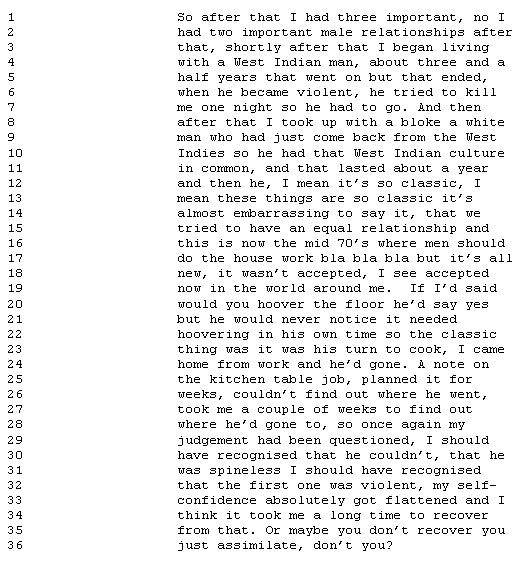
|
Extract 2
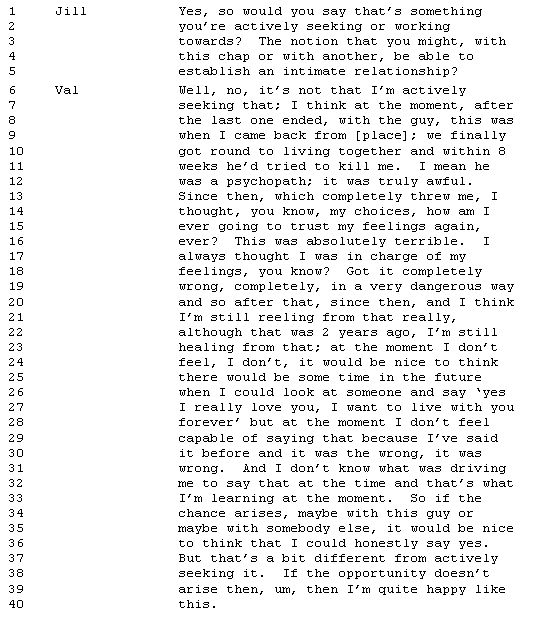
|
Extract 3
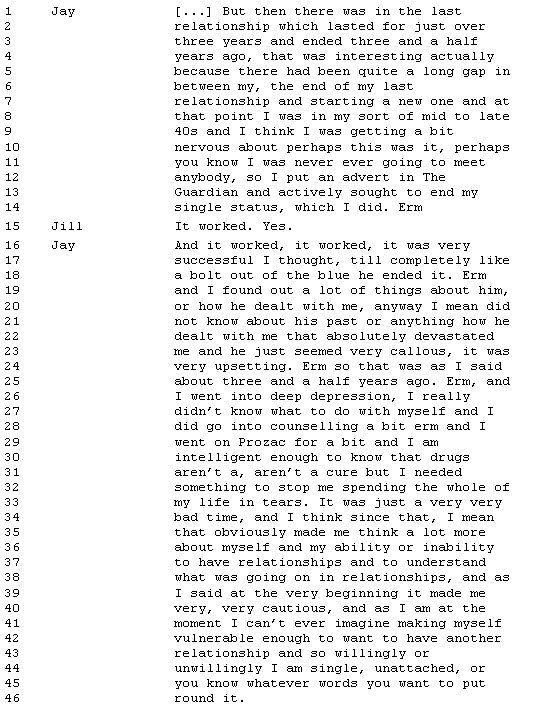
|
4.4 I expected to hear stories from participants of the failings in the men in their lives, and perhaps some anger or resentment towards men as a category. In these three extracts men are indeed found wanting in a number of ways. They don't play an equal part in housework, they are spineless, they let you down, they are deceitful and dishonest. In the worst cases (Extracts 1 and 2) they are violent, dangerous and try to kill you. It is striking that these are not presented as relationships that went wrong somewhere in their process, they are positionings of men as deep down faulty and potentially dangerous. Although a range of male failures and dangers are portrayed here, what these accounts have in common is the speaker's representation of herself as having failed to recognise the signs. But why does each speaker end her story by blaming herself for lacking judgement, rather than by expressing feelings about the man's failure or betrayal?
4.5 Edwards (1999) has pointed to the social acts that are performed in the different ways in which emotions are talked of. For instance, the use of metaphors or particular ways of describing events can work up behaviour as blameworthy, a temporary state or a continuing disposition. As a result the speaker positions him or herself as more reasonable or justified than others in their narrative (Edwards, 1999). However, in these extracts the 'emotion discourse' is focused not only on the speaker's reactions to the man's behaviour, but to her reaction to her own lack of judgement. In Extracts 1 and 2 the speaker's failure of judgement is the main focus. So, in Extract 2 'This was absolutely terrible' (line 16) refers to the speaker's lack of control of and inability to trust in her feelings. In Extract 1 'my self-confidence absolutely got flattened' (lines 3233) refers to her inability to recognise the man who was 'spineless' and the one who was 'violent'. In Extract 3 Jay works up some emotion about the man's behaviour in referring to 'a bolt out of the blue' (line 18) and 'that absolutely devastated me' (lines 2223). However, in a similar fashion to the first two extracts she turns later to thinking a lot more about herself and her 'ability or inability to have relationships and to understand what was going on in relationships' (lines 3437).
4.6 The work that talk of emotions is doing in these extracts is to represent the speaker as swept off her feet by emotion and as a result unable to use her own judgement. There is acknowledgement from Pauline in Extract 1 that the inequities in housework are a 'classic' story of the times (see also Jamieson, 1998). Yet principally participants are telling their own stories, rather than reflecting on men as a category. They focus on the effect on them of men who they portray as difficult. Participants position themselves as reasonable, as not really contributing to a problematic dynamic, and as a reasonable and sound person they need to account for their own connection to such clearly faulty individuals.
4.7 It is not unusual for women who have experienced domestic violence or abuse to blame themselves for events (see for instance Hague and Wilson, 2000). Loewenstein (1983) attributes a tendency generally in women towards self-blame as stemming from a popular belief that the mainspring for our actions lies within ourselves. She suggests that this gives women a sense of agency and control over their lives (Loewenstein, 1983). Lewis and Moon (1997) also found a tendency to self-blame in interviews exploring reasons for singleness. Although contrasting externalising of blame onto men also occurred from the same women, they often returned to identify what was wrong as within themselves. This apparently offered them a goal they could work on (lose weight, work on intimacy).
4.8 Conveying agency and a sense of being in charge of the direction of one's life appears to me to be a central feature here and in other extracts I discuss later. Producing a positive account of an agentic self is problematic when talking of relationships that have gone wrong, and perhaps this is heightened when it is the other person whose actions have ended the relationship, as appears to be the case in these three extracts. Finding the causes for disappointments in life within oneself may make some sense as part of a self-narrative that is concerned with making coherent connections between events. Representing oneself as having choices and agency over how relationships pan out can do important work in positioning a woman as in control of her life and not someone to be pitied (Reynolds, Wetherell and Taylor, forthcoming). However, it leaves women liable to blame themselves when things go wrong.
Relationships with unavailable men
4.9 Another interesting but problematic way in which participants spoke of men in their lives (either currently or in the past) was as not wholly available to them. Extracts 4 to 6 are examples of this.
Extract 4
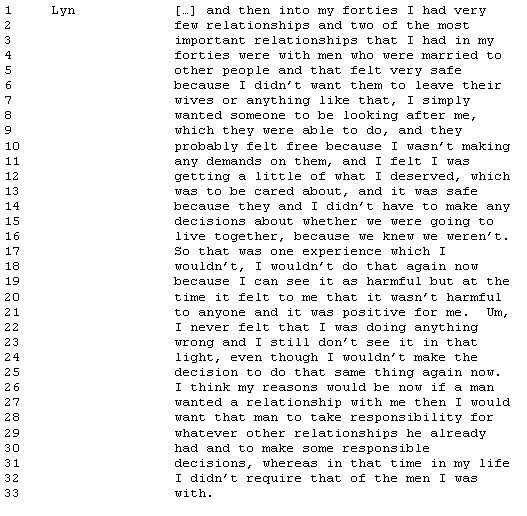
|
Extract 5
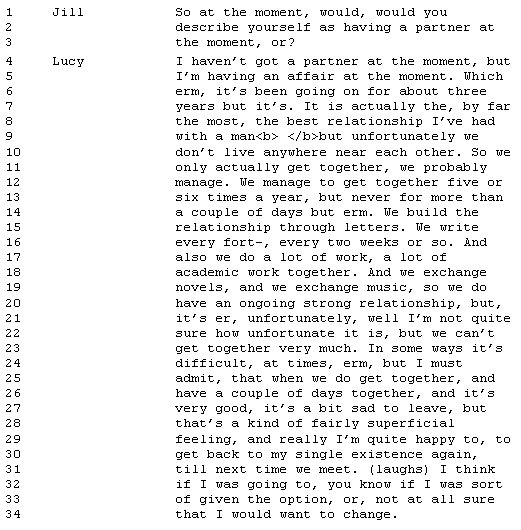
|
Extract 6
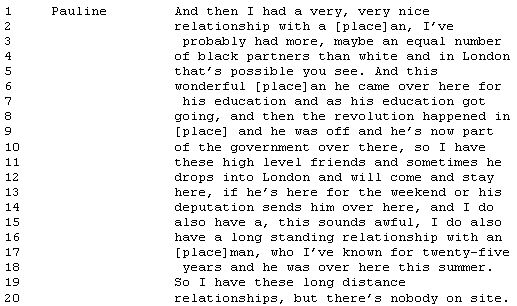
|
4.10 In Extract 4 married men are represented as 'safe', because the speaker did not want them to leave their wives and no decisions had to be made about whether to live together. The positioning of men in this speaker's talk is that there is a need to avoid making too many demands of them, and close relationships with men can be more trouble than they are worth. The men gave the speaker 'a little of what I deserved' (line 12). The speaker distances herself from the subject position of 'the other woman' doing wrong, by placing the events firmly in the past (lines 17 to 21). By attending to the possibility of criticism of her culpability 'I wouldn't do that again now' (line 18), she effectively positions herself as a moral and responsible person. In this extract, as in many others quoted here, the speaker can be seen to be positioning herself in relation to the larger argumentative cultural context referred to by Billig (1996) and Bamberg (2004).
4.11 The speaker asserts a position more on moral high ground for any potential future relationships by arguing that a man with other relationships who wants a relationship with her now should take responsibility for his decisions, although it is not made clear what this might mean (lines 26 to 31). There is a story of moral progress here she can see relationships with married men as harmful now but did not then. Yet she avoids any condemnation of her earlier self by her ambiguous statement in lines 2324, 'I still don't see it in that light' (wrong-doing), and the flat and distancing tone 'whereas in that time in my life I didn't require that of the men I was with' (lines 3133). Interestingly, she does not envisage a scenario where she might be the one who initiates a relationship, or needs to consider the effects of her own actions on others. The identity suggested is of an essential and continuing singleness. Alongside the implicit agency with which she depicts her engagement in relationships with married men is a gendered assumption that it is the man who wants the relationship in the first place.
4.12 In Extract 5 the speaker separates out from her 'single existence' (line 30), the relationship she calls an 'affair' (line 5). It is not made clear how having an affair differs from having a partner, and the explanation in lines 6 and 7 of its length (three years) suggests that length of relationship is not a distinguishing feature, although distance may be (lines 910). Having an affair allows the speaker to position herself as unequivocally single. Pursued through letters and intellectual exchange and occasional short periods together, the relationship is depicted as strong. However, Lucy repairs her initial portrayal of their distance from each other as unfortunate in lines 21 and 22, and puts a more positive framing on the impossibility of getting together much, referring to her sadness on leaving as 'a kind of fairly superficial feeling' (lines 28 to 29). Her reference to if she was 'given the option', in expressing uncertainty on whether she would want to change this arrangement, suggests that it may not be entirely in her power to make changes. Indeed, she depicts herself, and to a lesser extent the man involved, as having remarkably little agency in how the relationship is carried on. They 'don't live anywhere near each other' (lines 9 and 10), but there are no apparent thoughts of change so that they can get together more frequently. The subject position is almost that of a bystander to her own life and passive enjoyment of a relationship that does not require her to take action.
4.13 Extract 6 also refers to 'long distance relationships' (lines 1920), and as with Extract 5, it is not stated whether the men concerned are single. There are ethical issues involved in presenting oneself as having an affair with a married man, and rhetorical work is shown in Extract 4 which recovers some ethical status. The men referred to in Extracts 5 and 6 may be married or similarly committed elsewhere, but no accounting work is done here to explain the infrequency of the time together.
4.14 In Extract 6 the men are even more firmly placed at a considerable distance, and their visits are a bonus rather than events which might bring sadness at partings. There is a degree of positive 'racialising' of the identities (Frosh et al., 2000) in the 'equal numbers of black partners' (lines 34) (arguably of the speaker as white as well as her preferred partners as black), and although the second place name (line 17) does not suggest racial difference, some of the 'high level' (line 11) nature of the distance relationships is by implication carried over to this relationship too. The speaker orients to a potentially shocking aspect (Jones, 2002) of her account with her aside 'this sounds awful' (line 15). This seems to refer to the disclosure of more than one distant, if infrequent, relationship, rather than any other commitments on the men's part. The subject position here is not of an observer but more an engaged cultivator of enviable long-term, if limited, relationships.
4.15 A depiction of married men as 'safe' seems to be a reversal of ordinary understandings of relationships. It might be expected that commitment would be seen as desirable in relationships, and associated with feeling safe and secure. For Lyn however, in Extract 4, safety consisted of not having to make decisions about commitment. In her study of 65 single women involved with married men, Richardson found that because such relationships were defined as temporary, they were similarly seen by the women concerned as safe (Richardson, 1988). Not one of the women she interviewed had an expectation in the beginning stage of a long-term or permanent relationship with her lover. Richardson suggests that the notion of safety and the secrecy of the relationship, required by the man's marital status, led in time to greater emotional intimacy. However, Richardson argues that such liaisons proved particularly safe for the men involved, while the secrecy, which meant that the women lacked public acknowledgement of their status, increased women's dependence on the married man's attentions.
4.16 My participants were not necessarily referring to married men or secrecy when they talked of relationships with men who were not fully available. What I find to be a common feature of their narratives is the portrayal of the speaker as gaining some control and autonomy in a relationship that is nonetheless limited through the man's physical distance, emotional availability or personal commitments elsewhere. They are relationships with 'boundaries' (see Anderson and Stewart, 1994), yet it is not always clear who has set the boundaries.
A 'five year term of office'
4.17 This pattern of telling introduces what might be termed a 'new realism' about relationships, with which the analyses of changing features of relationships in late modernity have some resonance. Relationships with men are depicted as lasting for a period and then no longer meeting needs and so finished. Extracts 7 and 8 are examples.
Extract 7
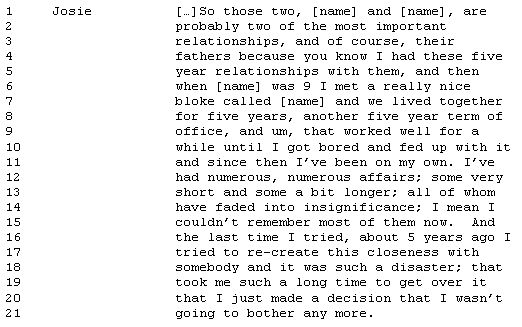
|
Extract 8
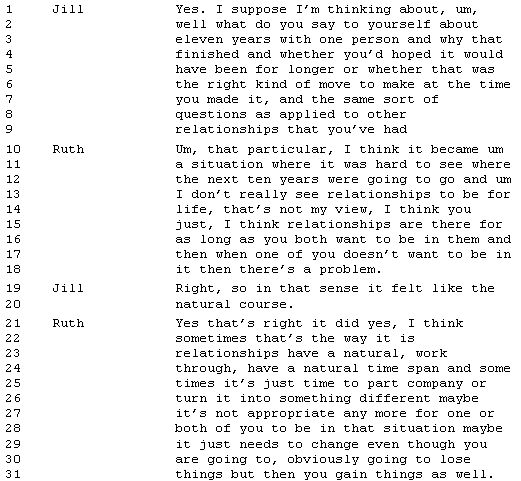
|
4.18 In Extract 7, Josie refers to her relationships with her children as 'the most important' (lines 1 to 3) and then adds in their fathers as a very passing reference, together with one further relationship. Each of these relationships lasted five years and this appears to link these three relationships into one category. The last one worked well until she was bored with it, but her ironic characterisation of a 'five year term of office' (lines 89) inserts some self-criticism and poignancy into this apparently low-key description. It is not made clear how the relationships came to an end, although her description of herself as bored and fed up works to assign her agency in bringing the third one mentioned to a close. She goes on to refer to affairs that are less memorable and an attempt at 'closeness' that is more evocative of disappointment and damage. A distinction is made between the relatively substantial (although impermanent) relationships that all lasted for five year periods and 'affairs'. It is not clear what the distinguishing features of an affair are, apart from duration, or how these related sequentially to the more important relationships referred to. The sequencing of reference to trying to 're-create this closeness' immediately after talk of affairs has the effect of suggesting both that this relationship falls into the affair category and that closeness is the distinguishing factor in relationships that are categorised as important.
4.19 Ruth, in Extract 8, talks of her partnership and justifies its ending through the idea of relationships as not for life but 'as long as you both want to be in them' (lines 13 to 16). She does not assign agency to either herself or her partner as initiating the end of the relationship, keeping the description impersonal as she explains 'when one of you doesn't want to be in it then there's a problem'. This nevertheless has the effect of suggesting she chose to end the relationship. Jill responds to the positive cast she is putting on events: 'it felt like the natural course', offering her a new resource which Ruth takes up in her next turn, working with the idea that relationships have a natural time span.
4.20 This pattern speaks of a new realism in how relationships with men are depicted. The relationships are described as having lasted for a period; then no longer meeting needs and so finished. There is a resigned acceptance that the relationships ended, and a more neutral tone to the narrative. This is not to argue that the relationships themselves were necessarily less emotional than others, simply to note that the pattern of descriptions was to unfold changes in the relationship without invoking the emotions in the telling. However, although a rather factual and unemotional tone was used from time to time by a number of participants in describing a particular relationship, it was rare for this tone to be maintained throughout the self-narrative. Extract 7 exemplifies a typical switch in tone as Josie moves on from talk of affairs to her description of a relationship as 'a disaster'.
4.21 Stories of relationships that finished when no longer meeting needs are not the tales of mourning a lost relationship and complaints of the man's failure to provide emotional intimacy or sense of betrayal from his infidelity that Riessman identified in her research with divorcing women (Riessman, 1990). 'A five year term of office' is a more contemporary theme. The relationships constructed here were valued for a period of time but then become irrelevant and no longer needed. There is some resonance in these stories with Giddens' argument that the 'pure relationship', continued only for as long as it is thought to deliver enough satisfaction for each individual to remain within it, has replaced a concept of 'romantic love' (Giddens, 1992). Bauman's notion of revocable relationships is similarly applicable (Bauman, 2003). There appear to be a different set of expectations from relationships in these stories from notions of commitment or the 'have/hold' discourse of monogamy, partnership and family life (Hollway, 1984). Indeed, the depictions in some ways counter what has been described as a 'largely uncontested Ideology of Marriage and Family' (DePaulo and Morris, 2005).
4.22 I suggest that the notion of some transience in intimate relationships offers a new discursive resource to women in constructing a self-narrative. I hold in abeyance questions of whether the nature of intimate relationships has really changed to a more impermanent and easily disposable arrangement, as this is not my focus. What is of interest to me is what this resource allows the speaker to accomplish in her self-narrative. In telling of relationships that are right for a time, the importance of a relationship is not detracted from. It can last for considerable periods of time five and eleven years in these extracts and can work well. Ruth, in Extract 8 takes up the idea of 'a natural time span', and such phrases simultaneously work to naturalise the account. This appears to be a peculiarly contemporary way of describing the ending of a relationship. This pattern of telling is ambiguous in its depiction of agency if relationships end because of boredom or because relationships do not have to be for life the speaker can retain some agency without assigning final responsibility for the ending of the relationship to either party. For Giddens (1992) the pure relationship condition of relating to others in an egalitarian way means autonomy. Yet the stories found in my data are inflected with acceptance rather than success. Like the other two patterns I have identified here, they are not entirely happy stories, and the narrators often went on to speak of their longing for closeness, their disappointment at not finding 'the other'.
Conclusion
5.1 A detailed analysis of stories of relationships with men shows some drawing on the changing landscape of intimate relationships, as identified by social theorists. Writers such as Giddens (1992) leave mysterious the detail of everyday lives and practices, and this study shows use of some changing cultural resources available for talking about singleness. Concepts of individualisation, boundaries and impermanence in relationships provide new cultural resources that women can draw on in providing a self-narrative.
5.2 The patterns I discuss here are not the only ways in which participants spoke of relationships with men. There were other common and distinctive features such as talk of partners who had not wanted children, relationships that were characterised as destructive as well as relationships that were said to combine warmth and freedom. I have chosen to focus on the three patterns discussed here because of the issues they demonstrate for a speaker in seeking to represent herself as self-determining and possessing agency in accounting for relationships that have ended or in which the other person's availability is limited. My analysis has highlighted the detailed rhetorical work involved in producing a positive account of the self as a single woman.
5.3 One pattern was to invoke an emotion discourse of self-blame, suggesting a high self-assignation of responsibility for relationships from participants. A focus was taken of work on the self rather than 'the other' following disappointment, dishonesty or even violence from the man. As well as constructions of men as deeply faulty, where participants blamed themselves for their poor judgement and flawed choice, there were other interesting variations in how relationships with men were constructed in the narratives. Men who were in some way unavailable were often portrayed in a positive light, for instance, providing a little bit of caring, intellectual companionship, or exotically distant and infrequent intimate episodes, none of which disturbed the stability and self-determination of the participant's independent life. A further construction of relationships with men was as variable over time right for a period but dispensable when their time was up. A depiction of relationships with men that last only as long as they are satisfying could be combined with wistfulness over difficulty in achieving closeness.
Notes
1The transcription notation in these extracts is a very simplified version of that developed by Gail Jefferson (see Atkinson and Heritage, 1984 for a fuller account).

|
2All participants chose or were given pseudonyms. Other potentially identifying details in the data have been omitted. Of the seven participants quoted in these extracts, six were ranged pretty evenly in ages from 45 to 60 years and one (Extract 8) was aged between 35 and 39 years. Their occupations were as further and higher education lecturers, a computer programmer, a housing manager and a student.
References
ADAMS, M. (1976) Single Blessedness: Observations on the Single Status in Married Society. New York: Basic Books.ANDERSON, C. M. and STEWART, S. (1994) Flying Solo: Single Women in Midlife. London: W.W. Norton.
ATKINSON, J. M. and HERITAGE, J. (1984) Structures of Social Action: Studies in Conversation Analysis, Cambridge: Cambridge University Press.
BAINBRIDGE, B. (2005) 'Waiting to grow up', The Guardian, Review, p. 4.
BAMBERG, M. (2004) 'Narrative discourse and identities', in J. C. Meister, T. Kindt, W. Schernus and M. Stein (editors) Narratology Beyond Literary Criticism. Berlin, New York: Walter de Gruyter, pp. 213237.
BAUMAN, Z. (2003) Liquid Love: On the Frailty of Human Bonds. Cambridge: Polity.
BECK, U. and BECK-GERNSHEIM, E. (2001) Individualization. London: Sage.
BILLIG, M. (1996) Arguing and Thinking: a Rhetorical Approach to Social Psychology,. Cambridge: Cambridge University Press.
BILLIG, M. (1997) 'Discursive, rhetorical and ideological messages' in C. McGarty and A. Haslam (editors) The Message of Social Psychology. Oxford: Blackwell.
BRUNER, J. (1990) Acts of Meaning. Cambridge, Massachusetts: Harvard University Press.
BRUNER, J. (1991) 'The narrative construction of reality', Critical Inquiry, Vol. 18, No.1, pp. 121.
CROSSLEY, M. (2000) Introducing Narrative Psychology: Self, Trauma and the Construction of Meaning. Buckingham: Open University Press.
DAVIES, B. and HARRΙ, R. (1990) 'Positioning: the discursive production of selves', Journal for the Theory of Social Behaviour, Vol. 20, No.1, pp. 4363.
DEPAULO, B. M. and MORRIS, W. L. (2005) 'Singles in society and in science', Psychological Inquiry, Vol. 16, Nos. 23, pp. 5783.
EDLEY, N. (2001a) 'Analysing masculinity: interpretative repertoires, ideological dilemmas and subject positions', in M. Wetherell, S. Taylor and S. J. Yates (editors) Discourse as Data: a Guide to Analysis. London: Sage, pp. 198228.
EDLEY, N. (2001b) 'Unravelling social constructionism', Theory and Psychology, Vol. 11, No. 3, pp. 433441.
EDLEY, N. (2002) 'The Loner, the Walk and the Beast Within: narrative fragments in the construction of masculinity', in W. Patterson (editor) Strategic Narratives: New Perspectives on the Power of Personal and Cultural Stories. Oxford: Lexington Books, pp. 127145.
EDWARDS, D. (1999) 'Emotion discourse', Culture and Psychology, Vol. 5, No. 3, pp. 271291.
FROSH, S., PHOENIX, A. and PATTMAN, R. (2000) ''But it's racism I really hate': young masculinities, racism and psychoanalysis', Psychoanalytic Psychology, Vol. 17, pp. 225242.
GERGEN, K. J. (1994) 'Self-narration in social life' in K. J. Gergen (editor) Realities and Relationships: Soundings in Social Construction. London: Harvard University Press, pp. 185209.
GIDDENS, A. (1992) The Transformation of Intimacy: Sexuality, Love and Eroticism in Modern Societies. Cambridge: Polity Press.
GORDON, T. (1994) Single Women: On the Margins? Basingstoke: Macmillan.
HAGUE, G. and WILSON, C. (2000) 'The silenced pain: domestic violence 19451970', Journal of Gender Studies, Vol. 9, No. 2, pp. 157169.
HOLLWAY, W. (1984) 'Gender difference and the production of subjectivity' in J. Henriques, V. Couze, W. Hollway, C. Urwin and V. Walkerdine (editors) Changing the Subject. London: Methuen, pp. 227263.
JAMIESON, L. (1998) Intimacy: Personal Relationships in Modern Societies. Oxford: Polity.
JONES, R. L. (2002) '"That's very rude, I shouldn't be telling you that": older women talking about sex', Narrative Inquiry, Vol. 12, No.1, pp. 121143.
LEWIS, J. (2001) The End of Marriage? Individualism and Intimate Relations. Cheltenham: Edward Elgar.
LEWIS, K. G. and MOON, S. (1997) 'Always single and single again women: a qualitative study', Journal of Marital and Family Therapy, Vol. 23, No. 2, pp. 115134.
LOEWENSTEIN, S. F. (1983) 'A feminist perspective' in A. Rosenblatt and D. Waldfogel (editors) Handbook of Clinical Social Work. San Francisco, Jossey-Bass, pp. 518548.
MISHLER, E. (1999) Storylines: Craftartists' Narratives of Identity. London: Harvard University Press.
POTTER, J. and WETHERELL, M. (1987) Discourse and Social Psychology: Beyond Attitudes and Behaviour. London: Sage.
REYNOLDS, J. and TAYLOR, S. (2005) 'Narrating singleness: life stories and deficit identities', Narrative Inquiry, Vol. 15, No. 2, pp. 197215.
REYNOLDS, J., WETHERELL, M. and TAYLOR, S. (forthcoming) 'Choice and chance: negotiating agency in narratives of singleness', The Sociological Review.
RICHARDSON, L. (1988), 'Secrecy and status: the social construction of forbidden relationships', American Sociological Review, Vol. 53 (April), pp. 209219.
RIESSMAN, C. K. (1993) Narrative analysis. London: Sage.
RICOEUR, P. (1992) 'Life in quest of narrative', On Paul Ricoeur: Narrative and Interpretation, D. Wood. London: Routledge.
RIESSMAN, C. K. (1990) Divorce Talk: Women and Men Make Sense of Personal Relationships. London: Rutgers University Press.
RIESSMAN, C. K. (2002) 'Analysis of personal narratives', Handbook of Interview Research: Context and Method, J. F. Gubrium and J. A. Holstein, London: Sage.
SCHEGLOFF, E. A. (1997) '"Narrative Analysis" thirty years later', Journal of Narrative and Life History, Vol. 7, Nos.14, pp. 97106.
SIMPSON, R. (2006) 'The intimate relationships of contemporary spinsters', Sociological Research Online. http://www.socresonline.org.uk/11/3/simpson.html
SMITH, M. B. (1952) The Single Woman of Today: Her Problems and Adjustment. London: Watts.
TAYLOR, S. (2003) 'A place for the future? Residence and continuity in women's narratives of their lives', Narrative Inquiry, Vol. 13, No. 1, pp. 192215.
WETHERELL, M. (1998), 'Positioning and interpretative repertoires: conversation analysis and post-structuralism in dialogue', Discourse and Society, Vol. 9, No. 3, pp. 387412.
WILLIAMS, F. (2004) Rethinking families. London: Calouste Gulbenkian Foundation.

